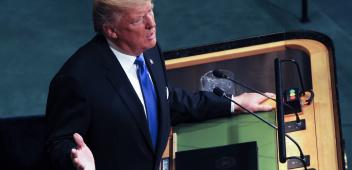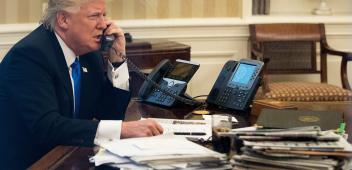Why Australia trembles as America teeters on the brink
In an opinion piece in The Age, Mark Thirwell discusses the last-minute negotiations to prevent the US economy from plunging lemming-like over the so-called fiscal cliff and back into recession.

Executive Summary
Why Australia trembles as America teeters on the brink
Mark Thirlwell
The Age
5 January 2013
The financial press has been absorbed by the last-minute negotiations to prevent the US economy from plunging lemming-like over the so-called fiscal cliff and back into recession.
This intensely political bargaining process, culminating in a stitched-together compromise based in large part around postponing dealing with several of the tougher issues, also occupied the minds of Australian politicians. Prime Minister Julia Gillard took to Twitter to urge a comprehensive solution to Washington's budgetary problems, while Treasurer Wayne Swan warned of the dangers for Australia if a deal failed to materialise, offered a lukewarm endorsement of the final outcome and took a swipe at the Tea Party.
So what was the so-called fiscal cliff, and why were the Australian Prime Minister and Treasurer moved to comment on US budgetary policy? And now that a deal has been reached, can we all forget about Washington's dysfunctional approach to fiscal matters and go back to enjoying our summer break?
Many of last week's machinations can be traced back to mid-2011, when Washington was locked in an earlier bout of fiscal-political fisticuffs. Back then, the fight was over the US debt ceiling: the US Congress sets restrictions on the size of federal government debt as a way of keeping control of the purse strings, and this legal limit had been reached by May 16.
President Barack Obama and the Republicans were locked in negotiations over a rise in the ceiling and the future trajectory of government spending, with the ultimate price for failing to reach agreement the prospect of a technical US debt default with unpredictable, but potentially severe, consequences for US and global financial market stability.
After months of wrangling, the two sides reached a compromise in the form of the Budget Control Act 2011. Basically, in return for a staged increase in the debt ceiling intended to carry the budget through until early 2013, the act established a supposedly bipartisan committee to agree on $US1.5 trillion of spending cuts over the next decade. Moreover, without agreement on at least $US1.2 trillion of cuts - a wholly predictable outcome given the almost complete absence of any actual bipartisanship - the act mandated a series of automatic spending cuts, or sequestrations, to take place in each fiscal year for the next decade, starting in January 2013. The deal was enough to avoid a technical default, although not enough to prevent ratings agency Standard & Poor's stripping the US of its AAA credit rating.
But it also created a potential spending time bomb.
This time bomb was even more dangerous because the end of 2012 would also bring the expiration of a series of supposedly temporary tax cuts, including the Bush-era income tax cuts of 2001 and 2003 along with a bunch of stimulus measures put in place in 2009 and 2010. In other words, if politicians did nothing, the start of this year would automatically deliver a bunch of tax increases and spending cuts. This was the fiscal cliff. And on most estimates, going over this cliff would be enough to tip the US economy back into recession.
So what's the Australian angle? Well, not surprisingly, a US recession would be bad news for us, too. Sure, the US has slipped down the rankings of our trading partners in recent years, but it's still our fifth-largest export market and our third-largest trading partner overall, albeit well behind China and Japan. It's also our largest investment partner by far. So a weaker US economy would have some direct spillovers for Australian growth.
More important, however, would be the indirect consequences of a US downturn via its impact on the global economy. Weaker US demand would most hurt growth in its immediate neighbourhood, but there would also be consequences for big regional exporters such as China, with knock-on effects for their demand for Australian resources. Weaker growth would likewise push commodity prices lower, providing another hit to local incomes.
In addition, there would be negative effects through the confidence channel, transmitted by nervous financial markets. Sitting at the epicentre of the global financial system, US financial shocks have a disproportionately large impact on the rest of the global economy - as evidenced by the havoc triggered by the global financial crisis.
The downside could be even larger. The global economy right now resembles a punch-drunk boxer who has spent the last couple of rounds on the ropes, but has somehow managed to hang on long enough for the bell to be in reach. In these circumstances, taking another blow risks a short, brutal trip down to the canvas.
Seen in this light, it's hardly surprising that Canberra has been keeping a nervous watch on developments in Washington. After all, the Treasurer has already had to concede that weaker global conditions have made the push for a return to a budget surplus this year unfeasible. A worse-than-expected outcome in the US, and hence the rest of the world, would only exacerbate his problems.
All of which means that last week's US deal to avoid crashing over the cliff was good news for the rest of us.
So, time to go back to the beach and forget about the details of US fiscal policy then? Not quite. Remember that debt ceiling problem that helped create the geology of the fiscal cliff? Well, as of the start of this year, the debt limit has once again been reached. The negotiations last week were supposed to fix this too, but didn't. So there's a fair chance for more US budget drama to come.



